- Home
- »
- Consumer F&B
- »
-
Meat Substitutes Market Size, Share & Growth Report, 2030GVR Report cover
![Meat Substitutes Market Size, Share & Trends Report]()
Meat Substitutes Market Size, Share & Trends Analysis Report By Source (Plant-based Protein, Mycoprotein, Soy-based, Others), By Distribution Channel (Foodservice, Retail), By Region, And Segment Forecasts, 2024 - 2030
- Report ID: 978-1-68038-405-5
- Number of Report Pages: 80
- Format: PDF, Horizon Databook
- Historical Range: 2018 - 2022
- Forecast Period: 2024 - 2030
- Industry: Consumer Goods
Meat Substitutes Market Size & Trends
The global meat substitutes market size was valued at USD 18.78 billion in 2023 and is expected to grow at a compound annual growth rate (CAGR) of 42.4% from 2024 to 2030. Intensive animal farming has faced criticism from certain segments of society due to its adverse impacts on both the environment and animal welfare. As a result, this has given rise to the emergence of diets that either exclude or restrict the consumption of animal products. This is expected to facilitate the market growth for meat substitutes.
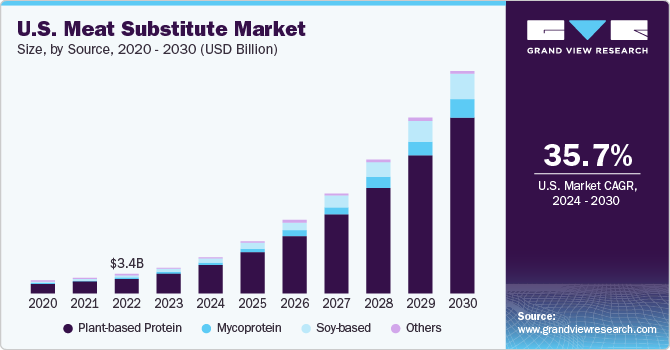
Moreover, the fear of an increasing number of animal-borne diseases has raised health concerns among consumers, which has resulted in decreased intake of animal products. The awareness among consumers regarding plant-based meat substitutes is experiencing rapid growth, as an increasing number of individuals are seeking these alternatives due to their acknowledged health advantages. These benefits include the potential prevention of non-communicable diseases, digestive problems, and obesity. .
In the present era, consumers have become highly mindful of their health due to the escalating incidence of obesity and diseases like heart disease and diabetes. Consequently, consumers are actively transforming their dietary choices and embracing healthier eating habits, which is anticipated to stimulate the demand for meat alternatives. The increasing awareness among consumers regarding the advantages of a vegan diet stands as a significant driver behind the global demand for plant-based products. Furthermore, the presence of cholesterol-free protein in these products serves as another crucial factor fueling their growth across various regions.
The enormous growth in the meat alternatives market is due to a mix of customer concerns and the ability of manufacturers to provide meat replacements with superior texture, flavor, and mouthfeel attributes. Gen Z and Millennials are driving demand for this industry, which is typically fueled by concern for health, climate change, and animal welfare. Many manufacturers have been partnering with brands to offer products in this category. For instance, Next Meats, a company based in Tokyo, formed a partnership with Vegan Meat India in December 2021 to introduce meat-free products in the country.
Consumers have access to a wide array of products, offering them greater choices and inventive flavors, all the while catering to their dietary requirements. Even non-vegetarian and non-vegan consumers are embracing plant-based alternatives for various reasons, including improved nutrition, weight management, concern for animal welfare, and long-term environmental sustainability.
Another popular trend is the use of whole veggies and grains on ingredient lists. For health-conscious buyers, seeing known substances on product labels is becoming increasingly vital. Consumers are increasingly looking for packages with reputable third-party certificates. Producers of meat substitutes are now providing products with transparent labeling that show whether the product is non-GMO, gluten free, vegan, and kosher. As a result, the increasing demand for plant-based alternatives and substantial investments in innovative products are expected to continue to offer profitable opportunity for the expansion of the market.
Market Concentration & Characteristics
The market demonstrates a medium to high degree of innovation, with companies consistently introducing new flavors, formulations, and functional ingredients to align with evolving consumer preferences. These substitutes have seen significant innovation in recent years, with companies developing new formulations and production methods to create products that closely mimic the taste, texture, and appearance of traditional meat. Similarly, lab-grown meat (also known as cultured or cell-based meat) represents a cutting-edge approach to meat production that has the potential to revolutionize the industry.
Mergers and acquisitions are in the range of medium to high in the meat substitutes industry. Companies undergoing mergers and acquisitions are seeking strategic partnerships to enhance their product portfolios, expand their market presence, and leverage on each other’s strengths. Moreover, the competitive nature of the market has led to further encouraging the players to explore synergies, leading to occasional mergers and acquisitions aiming to gain a competitive edge and achieving economies of scale in the market.
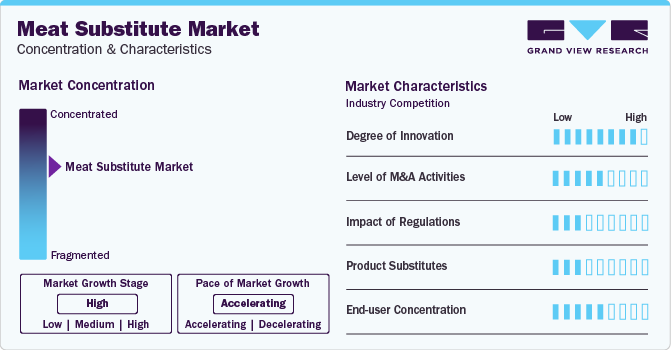
Regulatory authorities enforce precise labeling standards to ensure transparency and accurate information for consumers when it comes to meat substitutes. This includes the disclosure of specific food ingredients, their concentrations, and any potential allergens.
The presence of a significant meat-eating population is driving the sales and demand for animal-based meat. Additionally, the growing global population and rising income levels in certain parts of the world have led to an increase in the consumption of animal-based meat products. As a result, the demand for traditional meat
Source Insights
Plant-based protein segment held the largest market share of 62.45% in 2023 and is expected to maintain dominance over the forecast period. Meat shortages in different regions of the world, environmental concerns, and a desire to eat a healthier diet are some of the reasons driving the growth of this segmentPlant-based patties, along with popular snacks such as tofu and hummus, offer excellent choices for fulfilling daily protein needs. The global trend of plant protein is primarily driven by young, affluent customers, with wellness enthusiasts also contributing to the growth of this category.
The products made from plant protein and mycoprotein possess the texture, flavor, and nutritional properties of meat but are made from non-animal sources. Target plant proteins isolated from plants are put through hydrolysis to increase their functionality. Plant proteins are combined with components such as flour, food adhesives, and plant-based oil to create a meat texture. Protein inputs for new plant-based meat are plentiful and reasonably priced. Hence, the volume of meat substitutes from plant-based protein sources is high and is the main factor for the dominance of the segment.
However, the mycoprotein segment is projected to register the fastest growth during the forecast period, with a CAGR of 43.5% from 2024 to 2030. Owing to higher content of nutrients like fiber that helps in controlling blood cholesterol and blood sugar, consumers prefer mycoprotein food. Further, mycoprotein makes feel fuller than some animal proteins like chicken. This helps prevent overeating and weight gain. In addition, mycoprotein provides all essential amino acids, which is rarely found in other protein sources. Quorn, a mycoprotein brand, offer super-protein, healthy, meals for consumers. For vegans and vegetarians, meat alternatives were earlier limited to soya chunks mushrooms, and cottage cheese. Because of its texture and adaptability, jackfruit, as a newcomer to the market, has been generating a lot of buzz and gaining popularity. Because of its distinct qualities, the fruit is commonly referred to as a superfood because of its numerous nutritional benefits.
Distribution Channel Insights
Retail led the market and accounted for the largest market share of 65.96% in 2023. The segment includes all retail outlets such as hypermarkets, supermarkets, convenience stores, mini markets, and departmental stores. Consumers prefer these stores as they offer huge discounts and offers. Further, majority of the brands launch their product through big chains of supermarkets such as Walmart, Target, and others to reach maximum customers.
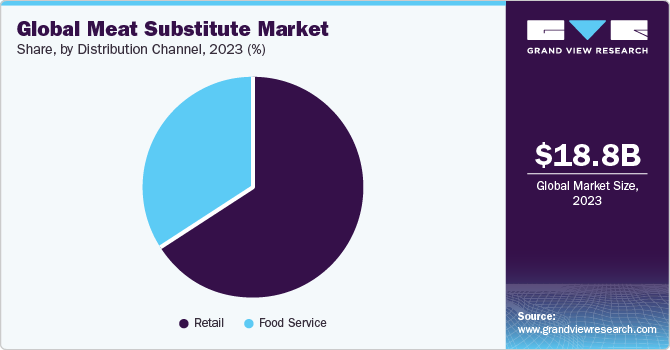
Foodservice is anticipated to register faster growth during forecast years with a CAGR of 42.8% from 2024 to 2030. The category includes outlets such as restaurants, lounges, and hotels. The major factor driving the demand for foodservice segment is the growing demand for customization and innovation in food menu options. Consumers enjoy a broad selection of choices when it comes to personalizing their meals to suit their individual tastes, dietary requirements, and budgetary considerations.
Plant proteins are experiencing huge demand, with retailers offering plant-based protein products and restaurants introducing plant-protein menu innovations. Consumers throughout the world, including vegetarian, non-vegetarian, and flexitarian, are responding with eagerness and enthusiasm for innovative products such as meat-like plant protein lattes, plant protein burgers and plant-based protein meal kits. Consumers benefit from manufacturers' enthusiastic response to the trend in two ways: availability and price obstacles are reducing as more plant-based protein products are launched in specialty, conventional supermarket, and foodservice channels.
Regional Insights
Europe made the largest contribution in the global market with maximum share in 2023. The region has been witnessing high demand, both from young and elder consumers. This is primarily due to an increase in vegan & flexitarian consumer base and rise in awareness among consumers regarding animal welfare. 10 years ago, meat alternatives were virtually non-existent in Germany. However, with the entrance of renowned processed food companies, Germans have caught up with Americans in terms of their consumption of meat substitutes. The collaboration between McDonald's and Nestlé, a prominent player in the meatless industry, to introduce a vegan burger in Germany is not a coincidence.
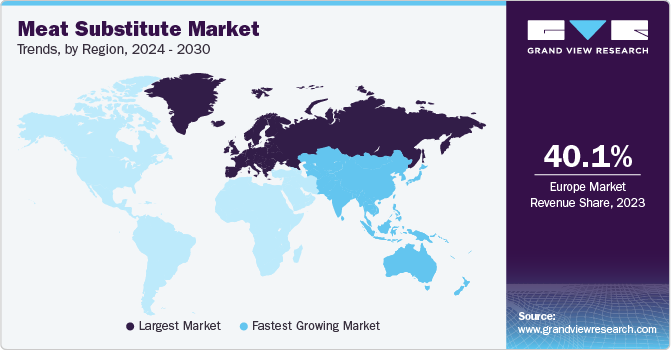
North America accounted for the second largest share of 32.45% in 2023. The majority of people rely on meat products for their daily protein needs in the region. There has been a significant shift in consumer attitudes towards plant-based diets and sustainability. More people in North America are adopting vegetarian, vegan, or flexitarian lifestyles, seeking healthier and more environmentally friendly food choices. This growing consumer demand is driving the expansion of the meat substitutes market.
Many consumers are becoming more health-conscious and are actively seeking out alternatives to traditional meat products. Meat substitutes offer a plant-based protein option that is often lower in saturated fat and cholesterol compared to animal meat. They can also provide additional nutritional benefits, such as being a good source of fiber and containing various vitamins and minerals. According to a survey by the International Food Information Council, the consumption of products that possess the same flavor and texture as animal protein but are made with only plant products was reported by nearly two out of three people (65%). In particular, 20% claimed they consumed them at least weekly, and a slightly higher percentage (22%) said they did so every day.
Asia Pacific is the fastest-growing market and is expected to witness a CAGR of 47.1% from 2024 to 2030. Countries like China and Australia contribute most of the share in the region. Rising health consciousness and social media influence have led to increased consumption of such products in these countries.As the trend moves away from consuming animal protein and towards adopting a plant-based diet, there has been a significant increase in the demand for top-notch plant-based alternatives. In the past, there were limited options available for high-quality vegetarian and vegan substitutes, often relying on unhealthy and heavily processed ingredients.
Several Asian consumers are exhibiting heightened concerns regarding food safety, health, and environmental impact, leading many to proactively modify their diets to embrace healthier and more sustainable lifestyles. The potential for introducing new and delectable food options in Asia is undoubtedly substantial, with customers desiring these choices as their primary preference rather than mere alternatives. In April 2021, ADM marked the inauguration of its state-of-the-art plant-based innovation laboratory at the Biopolis research hub in Singapore. This development aims to meet the growing food and beverage demands in the Asia-Pacific region. The laboratory's focus is on developing cutting-edge, trendy, and nutritious products.
Key Companies & Market Share Insights
The market comprises companies with a strong hold on meat substitutes and is still developing, where new entrants are launching products, and other key players in the market are planning to launch their products due to the increasing health concern owing to rising animal-borne diseases across the globe. Some of the initiatives taken are:
-
In August 2023, Nestlé expanded its range of plant-based products, offering consumers more options for meat alternatives. The company launched a line of shelf-stable plant-based cooking solutions in Chile under the Maggi Veg brand, including plant-based minced meat and lentil and vegetable soup. These products are designed to be accessible, affordable, and sustainable, with a longer shelf-life than frozen or fresh products.
-
In January 2022, KFC launched Beyond Fried Chicken made up of plant-based meats at different locations globally
-
In December 2021, ITC Ltd launched plant-based meat products, in anticipation of the burgeoning demand for meat substitutes and vegan meals in India
Key Meat Substitutes Companies:
- Amy’s Kitchen, Inc.
- Beyond Meat
- Impossible Foods Inc.
- Quorn Foods
- Kellogg Co.
- Unilever
- Meatless B.V.
- VBites Foods Ltd.
- SunFed
- Tyson Foods, Inc.
Meat Substitutes Market Report Scope
Report Attribute
Details
The market size value in 2024
USD 28.17 billion
The revenue forecast in 2030
USD 234.66 billion
Growth Rate
CAGR of 42.4% from 2024 to 2030
Base year for estimation
2023
Historical data
2018 - 2022
Forecast period
2024 - 2030
Report updated
January 2024
Quantitative units
Revenue in USD Million and CAGR from 2024 to 2030
Report coverage
Revenue forecast, company ranking, competitive landscape, growth factors, and trends
Segments covered
Source, Distribution Channel and Regions
Regional scope
North America, Europe; Asia Pacific; Central & South America; Middle East & Africa
Country scope
U.S.; Canada; Mexico; Germany; U.K.; France; Spain; Italy; China; Japan; India; Australia & New Zealand; South Korea; Brazil; South Africa
Key companies profiled
Amy’s Kitchen, Inc. , Beyond Meat, Impossible Foods Inc., Quorn Foods, Kellogg Co., Unilever, Meatless B.V. , VBites Foods Ltd., SunFed , Tyson Foods, Inc.
Customization scope
Free report customization (equivalent up to 8 analysts working days) with purchase. Addition or alteration to country, regional & segment scope.
Pricing and purchase options
Avail customized purchase options to meet your exact research needs. Explore purchase options
Global Meat Substitutes Market Report Segmentation
This report forecasts revenue growth at regional levels and provides an analysis on the latest trends and opportunities in each of the sub-segments from 2018 to 2030. For this study, Grand View Research has segmented the global meat substitutes market based on source, distribution channel , and region.
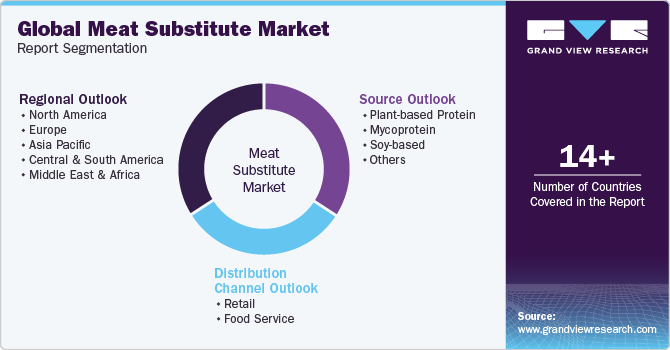
-
Source Outlook (USD Million; 2018 - 2030)
-
Plant-based Protein
-
Mycoprotein
-
Soy-based
-
Others
-
-
Distribution Channel Outlook (USD Million; 2018 - 2030)
-
Retail
-
Food Service
-
-
Regional Outlook (Revenue, USD Million; 2018 - 2030)
-
North America
-
U.S.
-
Canada
-
Mexico
-
-
Europe
-
U.K.
-
Germany
-
France
-
Italy
-
Spain
-
-
Asia Pacific
-
China
-
Japan
-
India
-
Australia & New Zealand
-
South Korea
-
-
Central & South America
-
Brazil
-
-
Middle East & Africa
-
South Africa
-
-
Frequently Asked Questions About This Report
b. The global meat substitutes market size was estimated at USD 18.78 billion in 2023 and is expected to reach USD 28.17 billion in 2024.
b. The global meat substitutes market is expected to grow at a compound annual growth rate of 42.4% from 2024 to 2030 to reach USD 234.66 billion by 2030.
b. North America held a revenue share of 32.45% in 2023. This is attributable to the increasing preference for vegan diets, driven by a growing awareness of health benefits. Moreover, heightened consciousness regarding environmental and ethical concerns has further propelled the market's growth.
b. Some of the major players in the market include Amy’s Kitchen Inc., Beyond Meat, Impossible Foods Inc., Quorn Foods, Kellogg Co., Unilever, Meatless B.V. , VBites Foods Ltd., Sunfed, and Tyson Foods, Inc.
b. The awareness among consumers regarding plant-based meat substitutes is experiencing rapid growth, as an increasing number of individuals are seeking these alternatives due to their acknowledged health advantages.
Share this report with your colleague or friend.
![gvr icn]()
NEED A CUSTOM REPORT?
We can customize every report - free of charge - including purchasing stand-alone sections or country-level reports, as well as offer affordable discounts for start-ups & universities. Contact us now
![Certified Icon]()
We are GDPR and CCPA compliant! Your transaction & personal information is safe and secure. For more details, please read our privacy policy.
We are committed towards customer satisfaction, and quality service.
"The quality of research they have done for us has been excellent."





